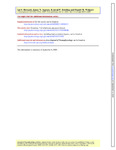Statistics of Natural Movements Are Reflected in Motor Errors
| dc.contributor.author | Howard, Ian | |
| dc.contributor.author | Ingram, JN | |
| dc.contributor.author | Körding, KP | |
| dc.contributor.author | Wolpert, DM | |
| dc.date.accessioned | 2016-06-02T12:11:31Z | |
| dc.date.available | 2016-06-02T12:11:31Z | |
| dc.date.issued | 2009-09 | |
| dc.identifier.issn | 0022-3077 | |
| dc.identifier.issn | 1522-1598 | |
| dc.identifier.uri | http://hdl.handle.net/10026.1/4804 | |
| dc.description.abstract |
<jats:p> Humans use their arms to engage in a wide variety of motor tasks during everyday life. However, little is known about the statistics of these natural arm movements. Studies of the sensory system have shown that the statistics of sensory inputs are key to determining sensory processing. We hypothesized that the statistics of natural everyday movements may, in a similar way, influence motor performance as measured in laboratory-based tasks. We developed a portable motion-tracking system that could be worn by subjects as they went about their daily routine outside of a laboratory setting. We found that the well-documented symmetry bias is reflected in the relative incidence of movements made during everyday tasks. Specifically, symmetric and antisymmetric movements are predominant at low frequencies, whereas only symmetric movements are predominant at high frequencies. Moreover, the statistics of natural movements, that is, their relative incidence, correlated with subjects' performance on a laboratory-based phase-tracking task. These results provide a link between natural movement statistics and motor performance and confirm that the symmetry bias documented in laboratory studies is a natural feature of human movement. </jats:p> | |
| dc.format.extent | 1902-1910 | |
| dc.format.medium | Print-Electronic | |
| dc.language | en | |
| dc.language.iso | eng | |
| dc.publisher | American Physiological Society | |
| dc.subject | Arm | |
| dc.subject | Elbow | |
| dc.subject | Feedback | |
| dc.subject | Humans | |
| dc.subject | Male | |
| dc.subject | Models, Statistical | |
| dc.subject | Movement | |
| dc.subject | Psychomotor Performance | |
| dc.subject | Range of Motion, Articular | |
| dc.title | Statistics of Natural Movements Are Reflected in Motor Errors | |
| dc.type | journal-article | |
| dc.type | Journal Article | |
| dc.type | Research Support, Non-U.S. Gov't | |
| plymouth.author-url | https://www.webofscience.com/api/gateway?GWVersion=2&SrcApp=PARTNER_APP&SrcAuth=LinksAMR&KeyUT=WOS:000269496700049&DestLinkType=FullRecord&DestApp=ALL_WOS&UsrCustomerID=11bb513d99f797142bcfeffcc58ea008 | |
| plymouth.issue | 3 | |
| plymouth.volume | 102 | |
| plymouth.publication-status | Published | |
| plymouth.journal | Journal of Neurophysiology | |
| dc.identifier.doi | 10.1152/jn.00013.2009 | |
| plymouth.organisational-group | /Plymouth | |
| plymouth.organisational-group | /Plymouth/Faculty of Science and Engineering | |
| plymouth.organisational-group | /Plymouth/Faculty of Science and Engineering/School of Engineering, Computing and Mathematics | |
| plymouth.organisational-group | /Plymouth/REF 2021 Researchers by UoA | |
| plymouth.organisational-group | /Plymouth/REF 2021 Researchers by UoA/UoA11 Computer Science and Informatics | |
| plymouth.organisational-group | /Plymouth/Users by role | |
| plymouth.organisational-group | /Plymouth/Users by role/Academics | |
| dc.publisher.place | United States | |
| dc.identifier.eissn | 1522-1598 | |
| dc.rights.embargoperiod | Not known | |
| rioxxterms.versionofrecord | 10.1152/jn.00013.2009 | |
| rioxxterms.licenseref.uri | http://www.rioxx.net/licenses/all-rights-reserved | |
| rioxxterms.type | Journal Article/Review |


